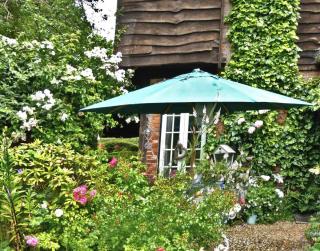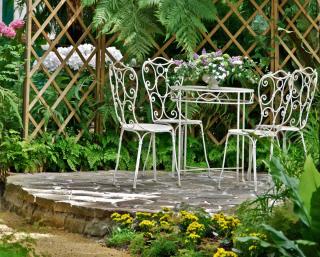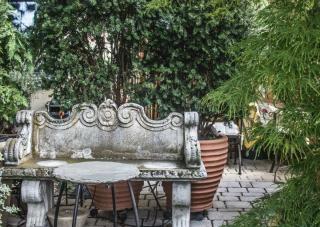

Small gardens, patios, urban gardens, subdivisions… Whenever buildings line the garden left and right, very often you’re left with a long strip of greenery to populate. Not an easy feat to landscape a long, narrow garden! Here are 5 key tips to turn that thin, linear space into an opportunity.
Read also:
 The first and most important solution to counter the dizzying depth of a long, narrow garden is to divvy it up into shorter, unique spaces. Each spot takes on different vibes with specific materials and plants. For instance, right up near the house, a terrace is the perfect location to position a full-sized table. Very inviting and convenient for lunching and dining outside! That wood-covered deck or stone landing opens to a winding path layered with gravel and lined with edge plants.
The first and most important solution to counter the dizzying depth of a long, narrow garden is to divvy it up into shorter, unique spaces. Each spot takes on different vibes with specific materials and plants. For instance, right up near the house, a terrace is the perfect location to position a full-sized table. Very inviting and convenient for lunching and dining outside! That wood-covered deck or stone landing opens to a winding path layered with gravel and lined with edge plants.
At the turn of the path, a cozy garden furniture sets awaits, perhaps against the backdrop of a vine-covered pergola. Through or around the pergola, a new path runs into an open clearing, where a small, tidy lawn can serve for both sunbathing and literal bathing, in a small swimming pool for example. Structuring your garden into zones that offer distinct atmospheres and serve different purposes is an excellent way to convert a boring urban space into a modern, contemporary landscaped garden.
 Terrace, lawn, pool… Like the rooms of a house, setting up each space enables versatility. One day a friendly gathering of neighbors, the next a romantic pick-nick or a wild treasure hunt for the kids. After mapping these spaces out, make use of different items or plants to structure borders: privacy panels, hedges and climbing plants. These implements will break the line of sight, thus creating small cocoon-like nests that’ll make you forget how long and narrow your outdoor garden is.
Terrace, lawn, pool… Like the rooms of a house, setting up each space enables versatility. One day a friendly gathering of neighbors, the next a romantic pick-nick or a wild treasure hunt for the kids. After mapping these spaces out, make use of different items or plants to structure borders: privacy panels, hedges and climbing plants. These implements will break the line of sight, thus creating small cocoon-like nests that’ll make you forget how long and narrow your outdoor garden is.
Regarding hedges, best maximize evergreen shrubs such as privet, Pittosporum or Mexican orange. Their perpetually green and lustrous foliage is joined in season with fragrant white or rosy flowers. As for climbing plants, ivy or star jasmine will for sure exquisitely cover a lattice or arbor in both sun and shade. If you favor view breakers instead, opt for designs that have patterns that are colorful and unique!
 Vegetable patches are both fun and useful! On top of producing luscious harvests, you can use it to repurpose part of your outdoor space. Rather than absolute squares, prefer rectangles. Set your raised beds with the narrow side to the wall, perpendicular to the long length of your garden. That’ll create a maze-like feel and will visually widen the space.
Vegetable patches are both fun and useful! On top of producing luscious harvests, you can use it to repurpose part of your outdoor space. Rather than absolute squares, prefer rectangles. Set your raised beds with the narrow side to the wall, perpendicular to the long length of your garden. That’ll create a maze-like feel and will visually widen the space.
And if you work an opening through the center or to the side, you can even make them span the entire width of the garden! Around an arch, twirl climbing vegetables such as beans or squash like the smaller red kuri. Arbors and arches will free space on the ground and growing plants vertically will greatly populate the area. You can even use natural staking for your beans and squash: simply plant corn and they’ll climb right up the stalk without compromising the corn harvest!
 Especially for gardens with slopes , working with several flat terraces or beds is a game-changer. Each flat spot becomes a unique place that offers greenery that fulfills various functions. Even if your garden is flat, it helps a lot to build some parts of the garden up in order to create two or more levels.
Especially for gardens with slopes , working with several flat terraces or beds is a game-changer. Each flat spot becomes a unique place that offers greenery that fulfills various functions. Even if your garden is flat, it helps a lot to build some parts of the garden up in order to create two or more levels.
Let’s say you want to set up 5 garden areas: barbecue and dining area, walkway, garden furniture set, another walkway, lawn.
As you start playing with artificial mounds and lower spots, you’ll completely transform how you appreciate your garden. Instead of a drab, boring strip, welcome to a constellation where each cocoon fits a different mood!
Plants throughout the entire garden will soften the hard, dry length of the garden. Lush growing beds full of perennials, grasses and shrubs will surround you with nature’s regenerative powers.
Feel free to pair opposing textures. For example, pair the light and elegant Deschampsia together with the arching straight lines of ornamental onion. Use taller evergreen shrubs in the background such as silverberry and surround it with Artemisia on the sunny side and Helxine in the shade. Pop in a few brightly colored blooms like rudbeckia, bellflower, lupine, aster, beeblossom, yarrow…
Remember to plan your garden areas with regards to seasons, too. A cool place in summer might turn rather cold in winter!